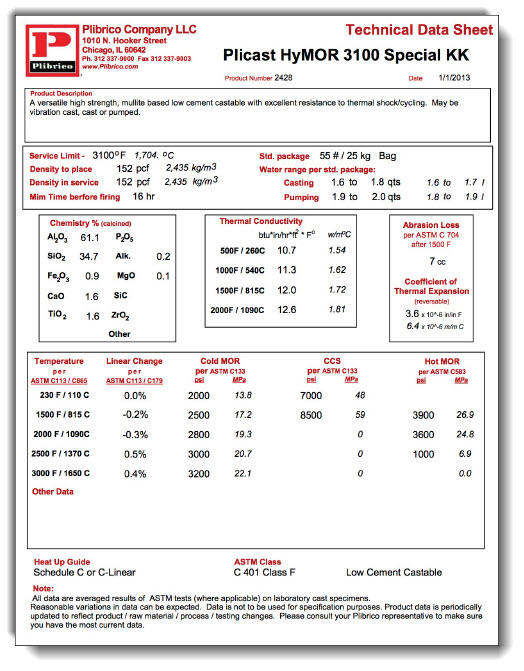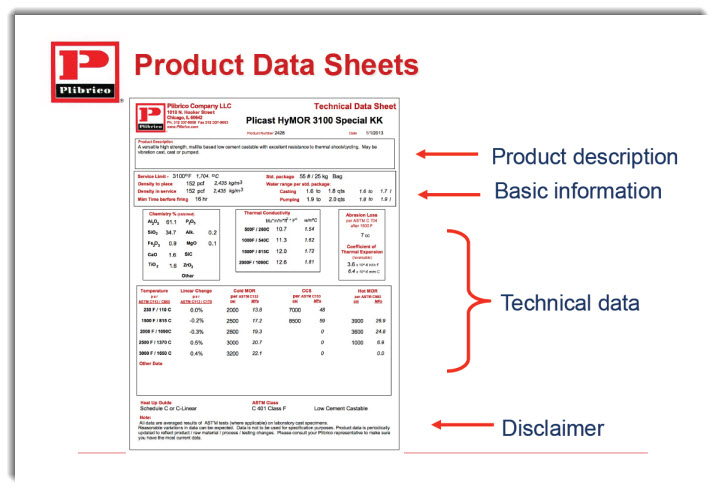Interpreting a Refractory Technical Datasheet
In our last post, we talked about the role of the refractory technical datasheet in the selection process. Today we’re going to share a datasheet and discuss how we evaluate them.
Let’s start out by reviewing a datasheet. This is for Plibrico’s Plicast HyMOR 3100 Special KK. (And thanks to our partner Plibrico for contributing to this post).  There’s a lot of good information here, but the first thing to remember is that data sheets are not product specifications! Data sheets present a variety of “typical” product physical and chemical characteristics, and are useful to group or compare available refractory products.
There’s a lot of good information here, but the first thing to remember is that data sheets are not product specifications! Data sheets present a variety of “typical” product physical and chemical characteristics, and are useful to group or compare available refractory products.
As you can see from the above example, data may be presented as an average or a range and subject to “normal” sampling and testing variations including:
- Test method / procedure
- R&R (repeatability and reproducibility)
- Size of the available data base
We follow the same approach as the Plibrico engineers for evaluating data sheets in the refractory selection process, starting with the basics, which includes an evaluation of:
- Chemical Analysis
- Mineralogy
- Service Limit
- Density
- Linear Change
- Thermal Expansion
- Strength
o CCS
o Cold MOR
o Hot MOR - Abrasion Loss
- Thermal Conductivity
If the refractory passes the basic criteria for its intended application, we then perform the advanced analysis, evaluating:
- Porosity
o Amount
o Size - ASG (apparent specific gravity)
- RUL (refractoriness under load)
- Creep
- Elastic Modulus
- Compressive Strain
- Thermal Shock Resistance
- Fracture Properties
o Fracture Toughness
o Work of Fracture
 Understanding the Disclaimers
Understanding the Disclaimers
After that, we evaluate the disclaimers. Data sheets almost always contain a disclaimer!
Here are a few examples from real data sheets:
- “All data are averaged results of ASTM tests on laboratory prepared samples. Reasonable variations can be expected. Data should not be used for specification purposes.”
- “This data represents average properties obtained on commercial production lots and should not be considered guaranteed specifications.”
- “This data contains typical properties only and should not be used for specification purposes. It is intended as a guide only. For specification and estimating purposes, contact your nearest “X” representative.”
What?
While these statements make it sound like the data might not be reliable, they’re meant to make it clear that you shouldn’t rely solely on the technical data. When interpreting a technical datasheet, it’s important to remember the following:
- Refractories are in an isothermal condition in very few applications
- Refractory linings exhibit a thermal gradient both through and between refractory layers
- Mineralogy, physical properties and textural characteristics therefore vary through the installed refractory thickness
As we mentioned in our previous post, the data should be evaluated along with all of the other relevant factors before making the final decision.
If you’re currently reviewing datasheets for a future application and would like some guidance interpreting the data, give us a call or connect with us online.
Comments are closed.

